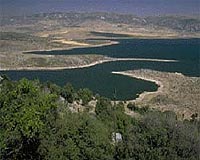| . |  |
. |
Paris (AFP) March 21, 2010 Scientists said on Sunday they had made a nanotech device to strip salt from seawater, paving the way to small-scale or even battery-powered desalination for drought-hit regions and disaster zones. The tiny prototype is reported on the eve of the UN's World Water Day, which aims to highlight the worsening problems of access to clean water. Conventional desalination works by forcing water through a membrane to remove molecules of salt. But this process is an energy-gobbler and the membrane is prone to clogging, which means that de-sal plants are inevitably big, expensive, fixed pieces of kit. The new gadget has been given a proof-of-principle test by Jongyoon Han and colleagues of the Department of Electrical Engineering and Computer Science at Massachusetts Institute of Technology (MIT). It works through so-called ion concentration polarisation, which occurs when a current of charged ions is passed through an ion-selective membrane. The idea is to create a force that moves charged ions and particles in the water away from the membrane. When the water passes through the system, salt ions -- as well as cells, viruses and micro-organisms -- get pushed to the side. This saltier water is then drawn off, leaving only de-salted water to pass through the main microchannel. The tiny device had a recovery rate of 50 percent, meaning that half of the water used at the start was desalinated. Ninety-nine percent of the salt in this water was removed. Energy efficiency was similar to or better than state-of-the-art large-scale desalination plants. "Rather than competing with larger desalination plants, the methods could be used to make small- or medium-scale systems, with the possibility of battery-powered operation," their paper, published by the journal Nature Nanotechnology, suggests. In an email to AFP, Han said the experiment entailed a tiny microfluidic chip, just a few millimetres (fraction of an inch) square, that desalted just 10 microlitres per minute. "The idea toward the real-world application is that we would make many of these devices, thousands or tens of thousands of them, on a plate, and operate them in parallel, in the same way semiconductor manufacturers are building many small electronic chips on a single large wafer," explained Han. "That would bring the flow rate up to around 100 millilitres (three fluid ounces) per minute level, which is comparable to typical household water purifiers and therefore useful in many applications." A patent has been filed for the device. However, it may be a matter of years before the invention reaches a commercial scale. At such early days, the costs of the future system are unknown. But, said Han, overheads may be significantly reduced because gravity can be used to put the water through the device, as opposed to forced it through by pumps, and there is less of a problem of membrane fouling. The theme of Monday's World Water Day is "Clean Water for a Healthy World," touching on the growing problem of water contamination in countries grappling with water stress and fast-rising populations.
Share This Article With Planet Earth
Related Links Water News - Science, Technology and Politics
 Lebanon's liquid treasure is just trickling away
Lebanon's liquid treasure is just trickling awayAmsheet, Lebanon (AFP) March 21, 2010 Rose Hatem's home overlooks the Mediterranean and is just a short distance from one of Lebanon's longest rivers. But twice a week the 60-year-old has to buy water for her daily needs. "I have been buying in water since I moved here 14 years ago," Hatem told AFP in the picturesque village of Amsheet, north of the Lebanese capital Beirut. "In the summer, when demand is high, I'm often left wit ... read more |
|
| The content herein, unless otherwise known to be public domain, are Copyright 1995-2010 - SpaceDaily. AFP and UPI Wire Stories are copyright Agence France-Presse and United Press International. ESA Portal Reports are copyright European Space Agency. All NASA sourced material is public domain. Additional copyrights may apply in whole or part to other bona fide parties. Advertising does not imply endorsement,agreement or approval of any opinions, statements or information provided by SpaceDaily on any Web page published or hosted by SpaceDaily. Privacy Statement |